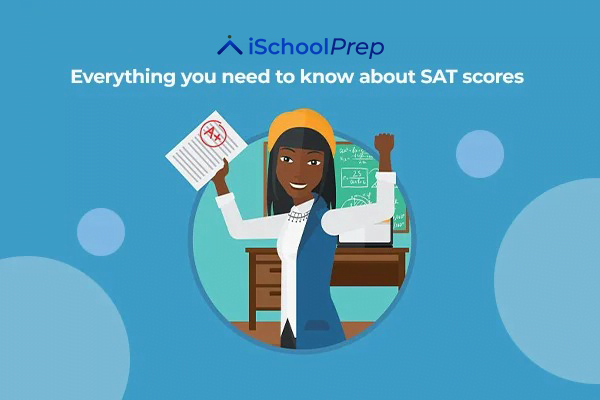Table of Contents
Are you a high school student planning to take the SAT? Do you find yourself wondering what is considered a good score and what scores you should aim for?
Well, you’re in luck because this blog post has got you covered! We’ll break down everything you need to know about SAT scores, including what a good score is, how to set target scores, and tips for achieving your goals. So sit back, relax, and let’s dive into the world of SAT scores!
SAT score | An overview
What constitutes a good SAT score will vary depending on the colleges and universities you are applying to. The SAT is only one component of an application, but in general, the higher your SAT score, the better your chances are of being accepted into a prestigious university.
Your extracurricular activities, volunteer work, essays, statements, and other factors are all considered in addition to your grades. You should still strive to do well on your SAT despite this.
What’s a good SAT score?
The SAT score range is 200–800 for each of your two section scores and 400–1600 for your overall score. Math scores make up one section, while evidence-based reading and writing scores combine evidence-based reading and writing scores (EBRW).
As you might anticipate, the better you performed compared to all other test-takers, the higher your score was. But is there a specific cutoff for the SAT that denotes a “good” score?
You must determine the actual mechanics of SAT scoring to determine what constitutes good SAT scores in comparison to everyone else. A percentile ranking is determined by your total score out of 1600 and your two section scores out of 800.
You can find out what percentage of students you scored the same as or better than using your SAT percentile. Therefore, if you received a score in the 60th percentile, you outperformed 60% of all test takers!

SAT composite scores have a mean of 1060. It should be noted that the test was specifically created so that the average score, or roughly 500 for each section, hovers around 1000 on the 1600-point scale. The average math score is 528, while the average EBRW score is 533.
Scores on the SAT have a normal distribution. Accordingly, it can be said that student performance typically falls in the middle of the scale (1000 is the halfway point between the minimum score of 400 and the maximum score of 1600). Significantly fewer test-takers achieve the higher and lower ends of the scale.
You can examine the score distribution yourself using the simplified SAT score chart below, which includes percentiles for SAT composite scores from the previous year.
| SAT Composite Score (Out of 1600) | Percentile (2021) |
| 1600 | 99+ |
| 1550 | 99 |
| 1500 | 98 |
| 1450 | 96 |
| 1400 | 93 |
| 1350 | 90 |
| 1300 | 86 |
| 1250 | 81 |
| 1200 | 74 |
| 1150 | 67 |
| 1100 | 59 |
| 1050 | 51 |
| 1000 | 42 |
| 950 | 34 |
| 900 | 26 |
| 850 | 19 |
| 800 | 12 |
| 750 | 7 |
| 700 | 3 |
| 650 | 1 |
| 600 and below | 1- |
Read more: GMAT Score Chart | 5 Tips to Enhance Your Exam Strategy!
The percentiles and corresponding scores show that more students fall between the top and bottom of the scale than in the middle.
For instance, if your score increases from 1000 to 1100 (100 points), you move up from the 42nd to the 59th percentile, passing almost half of the test takers! However, going from 1250 to 1350, or 100 points, only moves you up about 10%, from the 81st to the 90th percentile.
Last but not least, going from 1450 to 1550, a 100-point difference near the top of the scale, only gives you a profit of about 3%!
What’s a good SAT score for you?

We’ve talked about how your SAT score and corresponding percentile ranking indicate how you stack up against other test-takers so far.
However, you don’t place the greatest importance on how you perform in comparison to other people. What counts as a good SAT score for you specifically depends on the schools you are considering.
An 84th percentile score of 1280 indicates that you performed on par with or better than 84 percent of test-takers, making it a strong score for institutions like Arizona State University and Temple University (average SAT score: 1245). (average: 1238). For highly selective schools like MIT, Caltech, Duke, the University of Chicago, and Johns Hopkins, however, it would be a very low score.
Of course, not everyone aspires to attend highly selective institutions. For less selective colleges like Indiana University Northwest (average SAT score: 1000) and CSU Stanislaus, a score of 1040 (slightly below the 1050 average) is good (average: 980). A good SAT score is one that puts you in the running for the universities you want to attend.
Additionally, it’s important to keep in mind that the higher your test scores, the more likely it is that colleges offering merit scholarships will award one to you. This guide will primarily focus on determining the score you need for admission (not scholarships), but it’s important to keep in mind. Visit our guide to scholarships based on SAT/ACT scores for more details.
A high test score may also be useful if your GPA is lower than what is typically required for admission to a particular school. However, this won’t help you at highly selective institutions—they demand high marks across the board from students!
SAT scores for top schools

We’re providing you with an SAT score chart showing the 25th and 75th percentile SAT scores for 2020 for more than 50 well-known schools to assist you in setting your target score. To give you an idea of how selective each school is, I’ve also included the most recent US News ranking and acceptance rate. Every school is arranged according to rankings.
| University | 25th percentile SAT Score | 75th percentile SAT Score | Ranking | Acceptance Rate |
| Princeton | 1440 | 1570 | 1 | 6% |
| Harvard | 1460 | 1580 | 2 | 5% |
| Columbia | 1450 | 1560 | 2 | 6% |
| MIT | 1500 | 1570 | 2 | 6% |
| Yale | 1470 | 1560 | 5 | 6% |
| Stanford | 1440 | 1550 | 6 | 4% |
| UChicago | 1470 | 1570 | 6 | 7% |
| Penn | 1440 | 1560 | 8 | 8% |
| Caltech | 1530 | 1570 | 9 | 6% |
| Johns Hopkins | 1450 | 1560 | 9 | 11% |
Key Takeaways
- The range of possible SAT scores is 400 to 1600 in 10-point increments. This score’s EBRW and Math sections each have a 200–800 score range. A scale of 10 to 40 is used for both reading and writing on the EBRW.
- Three separate scores on a scale of 2–8 are assigned for the optional essay. Additionally, there are cross-test scores and subscores, which employ smaller scales of 1–15 and 10–40, respectively.
- The scoring scale on the old SAT was very different. Before 2016, the SAT had three sections (Critical Reading, Math, and Writing), each with a 200–800 scale, and the range of scores was 600–2400 in 10-point increments.
- According to the current SAT score range, the average SAT score is somewhere around 1000, which is the middle of the range. (The actual average for all 11th and 12th-grade students is 1051).
The SAT can be a challenging test, but with the right preparation and understanding of what constitutes a good score, you can set yourself up for success. Remember, a good SAT score is relative to your goals and the colleges you’re applying to.
Don’t be discouraged if you don’t achieve a perfect score; colleges consider a variety of factors when making admission decisions. With a clear understanding of what a good score is for you and the colleges you’re interested in, you can approach the SAT with confidence and maximize your chances of achieving your desired outcome.
We hope you enjoyed reading this blog. In case of any queries, reach out to us or drop a comment below!
Liked this blog? Read next: SAT subjects | The complete list of subject tests!
FAQ
Q1. How can I raise my SAT score?
Answer – Students preparing for the SAT are frequently perplexed about how much preparation is necessary and when they should begin. There are no simple solutions because each student’s preparation approach is unique. Do additional practice exams and work on your weak areas.
Q2. What is the best way to receive my SAT scores over the phone?
Answer – You must call international customer support at 212-713-7789 and follow the instructions carefully to receive your SAT score by phone.
Q3. When will the SAT scores be made public?
Answer – The SAT results are normally available one or two weeks after the exam date. You can verify their results by going to the College Board’s official website and selecting the exam date.






